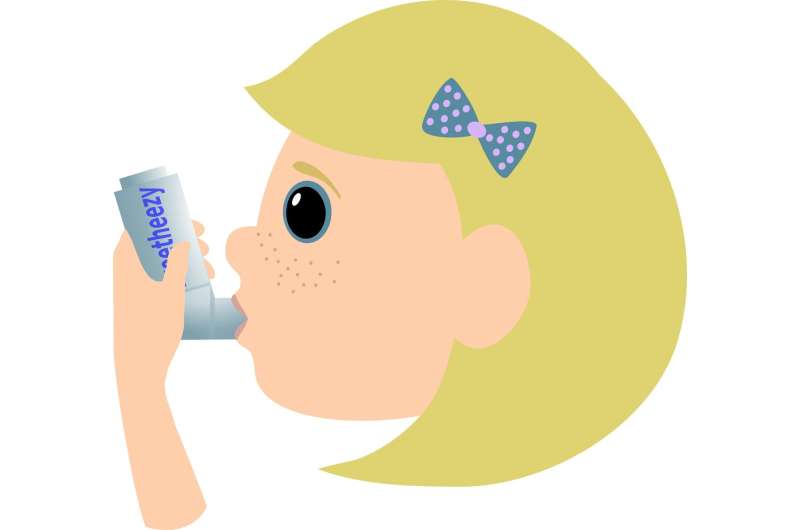Exposure to cadmium in the womb linked to childhood asthma and allergies

Babies born with higher levels of cadmium in their umbilical cord blood may be more likely to develop childhood asthma and allergies, according to research presented at the European Respiratory Society International Congress.
Cadmium is known to be hazardous to human health and its use is restricted in the European Union, but it has been widely used, for example in batteries, pigments and as a coating for other metals. It is also present in tobacco and can enter the body via smoking or passive smoking.
Researchers say their findings lend support for tight controls over the use and disposal of cadmium.
The research was presented to the virtual conference by Professor Isabella Annesi-Maesano, research director at France's Institut national de la santé et de la recherche médicale (INSERM) and head of the epidemiology of allergic and respiratory diseases department of the Institute Pierre Louis of Epidemiology and Public Health, INSERM and Sorbonne Université, Paris, France.
She said: "Cadmium is a type of heavy metal. We know that people can be exposed to heavy metals through food, water and air, and even very small amounts can have damaging effects on our health.
"We wanted to investigate the levels of certain heavy metals that babies are being exposed to in the womb and to understand any impact this could have on their development and future health."
The study included 706 women and their babies who were being cared for in maternity units in Nancy and Poitier in France. Researchers measured the quantities of three different heavy metals—cadmium, manganese and lead—in the women's blood while they were pregnant and in blood taken from their babies' umbilical cords after delivery.
Researchers followed the children up to the age of eight years and recorded whether any of them developed asthma, allergic rhinitis, eczema or food allergies. They also accounted for factors that are known to influence these conditions, such as the children's family medical history and whether their parents smoked.
Researchers found an average of 0.8 microgram of cadmium per litre (μg/L) in the mothers' blood and an average of 0.5 μg/L in cord blood.
The results suggest that higher levels of cadmium found in babies' umbilical cord blood (above 0.7 μg/L) were linked to a possible increased risk of asthma of around 24%, compared to lower levels (below 0.3 μg/L), and a likely increase in the risk of food allergies of around 44%. Higher levels of manganese in the mothers' blood (above 1.1μg/L) were also linked to a possible rise in the risk of eczema, compared to lower levels (below 0.5 μg/L). Eczema is known risk factor for developing asthma.
Professor Annesi-Maesano added: "We know from previous research that different types of heavy metals can affect different organs in the body. Our study suggests that exposure to cadmium in the womb could have a role in increasing the risk of asthma and allergies in children.
"Our study doesn't tell us why this might be the case, but it could be that cadmium is interfering with babies' developing immune systems and we think this can have an impact on their allergic reactions in childhood.
"We need more research to confirm these findings and to understand more about the links between exposure to heavy metals in the womb and children's health in the longer term."
Professor Annesi-Maesano and her team continue to study heavy metals and other environmental pollutants and their effects on asthma and allergies.
Daiana Stolz, who was not involved in the research, is the European Respiratory Society (ERS) Education Council Chair and is Professor of Respiratory Medicine and a leading physician at the University Hospital Basel, Switzerland. She said: "We know that heavy metals that are present in many everyday products can be damaging to health if they enter our bodies through the air we breathe, or our food and drink. It's particularly worrying to know that cadmium and other metals might be reaching unborn babies via the umbilical cord.
"We need to understand the possible causes of asthma and allergies in children so we can try prevent these conditions. This research indicates that higher levels of cadmium in cord blood could have an influence on children's risk of asthma and allergies, but it's a small study, so we do need to keep investigating this issue.
"Given the known dangers of cadmium and other heavy metals, this study supports extremely tight regulation of their use and careful disposal of products, such as batteries, that contain cadmium."
More information: Abstract no: OA3847 "Foetal exposure to heavy metals and risk of asthma and allergic diseases in early childhood: a population-based birth-cohort study", by Isabella Annesi-Maesano et al; Presented in session, "Workplace and outdoor air quality: from sensitisation to social media" at 11:50 hrs CEST, Monday 7 September 2020. k4.ersnet.org/prod/v2/Front/Pr … ?e=259&session=12394

















